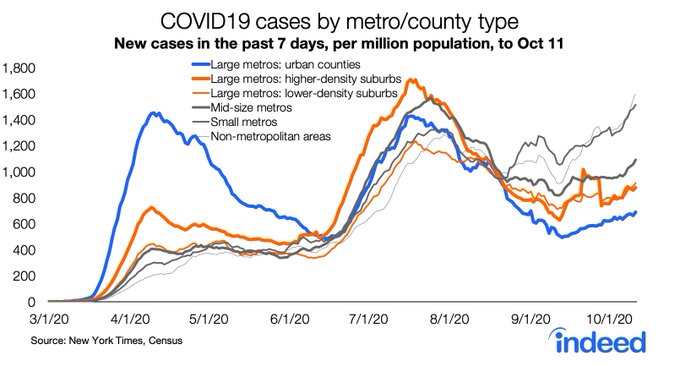What City Observatory did this week
1. Covid-19 is now worst in rural areas and red states. Early on in the pandemic, it seemed like everyone attributed the spread of the Coronavirus to big cities and density. It turns out, more than half a year on, that’s not the case. The epidemic is now far worse in the nation’s rural areas, which have 21 percent of new cases but just 14 percent of US population. A broad swath of rural and small metro America from the Gulf Coast to the Dakota’s, the politically red heartland is now the redzone for the virus.
The gap between urban and rural areas has widened in the past month, and we’re still waiting for the nation’s reporters to start filing stories about rural residents fleeing to the safety of the nation’s big cities, which now have, by far the lowest new case rates.
2. Equity and Parks. We’re pleased to present a guest commentary from Carol Coletta, President and CEO of Memphis Riverparks. Her remarks to the International Downtown Association’s 66th annual meeting make a strong connection between vibrant urban spaces, particularly parks, and promoting the kind of social mixing that’s needed to promote social mixing, break down the growing divisions in America, and broaden empathy. Downtown parks and public spaces are particularly important because they are the spaces most widely available to people from throughout the community. As Carol writes:
Successful downtowns increasingly depend on great public space. And great public space located in a downtown is more likely to be equitable space because of its location, not despite its location.
The pandemic has reminded us of the importance of these public spaces to our daily lives. One hopes that out of this crisis will grow a greater realization of the role they can play in bringing us closer together.
Must read
1. Building more roads won’t help America’s economy. From “infrastructure week” to presidential campaign shibboleths, the idea that we can revive our economy by building more roads and bridges is a commonplace. While it may have been true in the middle of the 20th Century, it’s flat out wrong today, as Chuck Marohn of Strong Towns argues in a commentary for CNN:
When local governments don’t maintain what they already have, can they credibly justify building more? Instead of pursuing economic growth through system expansion, recovery must be based on a firm commitment to maintaining what has already been built and squeezing higher returns out of these existing infrastructure investments.
Additionally, a statewide upzoning that allows developers to build in the most affluent, exclusive communities would take some of the pressure off moderate-income neighborhoods such as East Boston and Malden, which have been providing much of the region’s new housing. Allowing new construction in affluent, mostly white communities is one of the most effective ways to reduce the risk of gentrification and displacement in lower-income Black and Latino or Hispanic communities.
Following instructions from the White House, the Federal Transit Administration (FTA) disqualified transit agencies in New York City, Seattle, and Portland from participating in a new grant program to research methods to slow the spread of coronavirus on buses and trains. This move puts transit operators’ and riders’ safety at risk and sets a dangerous precedent that could undermine future economic recovery efforts.
New Knowledge
New insight on urban travel patterns. Brookings Institution’s Bass Center for Transformative Placemaking has a fascinating new report on the connections between land use and travel patterns. The report taps data from cell phones and smart devices assembled by Replica to profile travel patterns in six US metropolitan areas: Birmingham, Chicago, Dallas, Kansas City, Portland and Sacramento.
The study reports that cell phone data shows that the average trip taken in these metro areas was about 7.3 miles, and that the typical resident traveled about 21 miles per day. But those average mask significant variations, across metro areas, neighborhoods and individuals. Some metro areas have shorter trips: Portland’s average trip is 6.2 miles; Kansas City’s is 8.2 miles. Also, trip distances vary significantly across neighborhoods within metro areas, with urban neighborhoods generally having shorter trips than suburban ones. And finally, the data show that most trips are actually shorter.
A majority of trips in most metro areas are shorter than 4 miles; the seven mile average is a product of relatively few much longer trips.
This new Brookings study adds to the growing body of work tapping the stream of big data from cell phones and other smart devices to provide new data about transportation behavior. While its tantalizing in its detail, we’ll want to develop more experience with the data to better understand how it relates to other sources of data on travel patterns.
Adie Tomer, Joseph Kane, Jennifer Vey, Connecting people and places: Exploring new measures of travel behavior, October 2020. Anne T. and Robert M. Bass Center for Transformative Placemaking, Brookings Institution.
In the News
Bike Portland called our analysis of the proposed $5 billion transportation bond measure in Portland “a scathing takedown” and a “serious critique” of the measure.
The Portland Mercury also cited our analysis of the proposed Portland Metro transportation bond measure in its election editorial.


